Subaru Legacy: Front seats
 Subaru Legacy: Front seats
Subaru Legacy: Front seats
WARNING
● Never adjust the seat while driving to avoid the possibility of loss of vehicle control and of personal injury.
● Before adjusting the seat, make sure the hands and feet of rear seat passengers or cargo are clear of the adjusting mechanism.
● After adjusting the seat, push it slightly to make sure it is securely locked. If the seat is not securely locked, it may move or the seatbelt may not operate properly.
● Do not put objects under the front seats. They may interfere with front seat locking and cause an accident.
● Seatbelts provide maximum restraint when the occupant sits well back and upright in the seat. To reduce the risk of sliding under the seatbelt in a collision, the front seatbacks should be always used in the upright position while the vehicle is running. If the front seatbacks are not used in the upright position in a collision, the risk of sliding under the lap belt and of the lap belt sliding up over the abdomen will increase, and both can result in serious internal injury or death.
● The SRS airbags deploy with considerable speed and force. Occupants who are out of proper position when the SRS airbag deploys could suffer very serious injuries. Because the SRS airbag needs enough space for deployment, the driver should always sit upright and well back in the seat as far from the steering wheel as practical while still maintaining full vehicle control and the front passenger should move the seat as far back as possible and sit upright and well back in the seat.
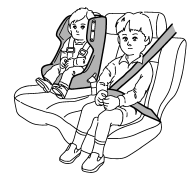
WARNING
Put children in the rear seat properly restrained at all times. The SRS airbag deploys with considerable speed and force and can injure or even kill children, especially if they are not restrained or improperly restrained. Because children are lighter and weaker than adults, their risk of being injured from deployment is greater. Consequently, we strongly recommend that ALL children (including those in child seats and those that have outgrown child restraint devices) sit in the REAR seat properly restrained at all times in a child restraint device or in a seatbelt, whichever is appropriate for the child’s age, height and weight.
Secure ALL types of child restraint devices (including forward facing child seats) in the REAR seats at all times.
NEVER INSTALL A REARWARD FACING CHILD SEAT IN THE FRONT SEAT. DOING SO RISKS SERIOUS INJURY OR DEATH TO THE CHILD BY PLACING THE CHILD’S HEAD TOO CLOSE TO THE SRS AIRBAG. According to accident statistics, children are safer when properly restrained in the rear seating positions than in the front seating positions. For instructions and precautions concerning child restraint systems, refer to “Child restraint systems” F1-25.
Manual seat
Forward and backward adjustment
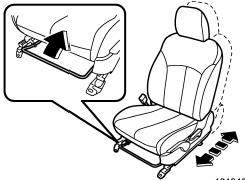
Pull the lever upward and slide the seat to the desired position. Then release the lever and try to move the seat back and forth to make sure that it is securely locked into place.
Reclining the seatback
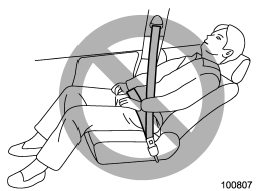
WARNING
To prevent the passenger from sliding under the seatbelt in the event of a collision, always put the seatback in the upright position while the vehicle is in motion. Also, do not place objects such as cushions between the passenger and the seatback. If you do so, the risk of sliding under the lap belt and of the lap belt sliding up over the abdomen will increase, and both can result in serious internal injury or death.
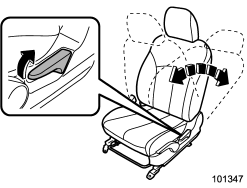
Pull the reclining lever up and adjust the seatback to the desired position. Then release the lever and make sure the seatback is securely locked into place.
The seatback placed in a reclined position can spring back upward with force when the lever is pulled. When operating the reclining lever to return the seatback, hold the seatback lightly so that it may be raised back gradually.
Seat height adjustment (driver’s seat)
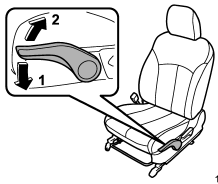
1) When the lever is pushed down, the seat is lowered.
2) When the lever is pulled up, the seat rises.
The height of the seat can be adjusted by moving the seat cushion adjustment lever up or down.
Power seat (if equipped)
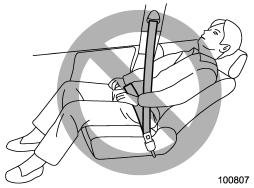
WARNING
To prevent the passenger from sliding under the seatbelt in the event of a collision, always put the seatback in the upright position while the vehicle is in motion. Also, do not place objects such as cushions between the passenger and the seatback. If you do so, the risk of sliding under the lap belt and of the lap belt sliding up over the abdomen will increase, and both can result in serious internal injury or death.
Driver’s seat
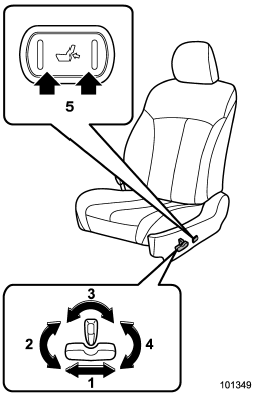
1) Seat position forward/backward control switch
To adjust the seat forward or backward, move the control switch forward or backward.
During forward/backward adjustment of the seat, you cannot adjust the seat cushion
angle or seat cushion height.
2) Seat cushion angle control switch
To adjust the seat cushion angle, pull up or push down the front end of the control
switch.
3) Seatback angle (reclining) control switch
To adjust the angle of the seatback, move the control switch.
4) Seat height control switch
To adjust the seat height, pull up or push down the rear end of the control switch.
5) Lumbar support control switch
To increase lower back support, push the front side of the switch. To decrease lower
back support, push the rear side of the switch.
Front passenger’s seat (if equipped)
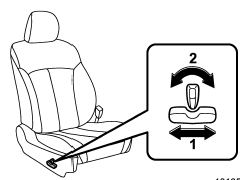
1) Seat position forward/backward control switch
To adjust the seat forward or backward, move the control switch forward or backward.
2) Seatback angle (reclining) control switch
To adjust the angle of the seatback, move the control switch.
Head restraint adjustment
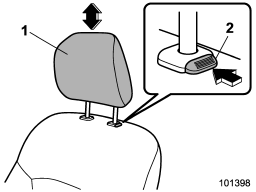
1) Head restraint
2) Release button
Both the driver’s seat and the front passenger’s seat are equipped with head restraints.
The head restraint should be adjusted so that the center of the head restraint is closest to the top of the occupant’s ears.
To raise:
Pull the head restraint up.
To lower:
Push the head restraint down while pressing the release button on the top of the
seatback.
To remove:
While pressing the release button, pull out the head restraint.
To install:
Install the head restraint into the holes that are located on the top of the seatback
until the head restraint locks.
WARNING
● Never drive the vehicle with the head restraints removed because they are designed to reduce the risk of serious neck injury in the event that the vehicle is struck from the rear. Therefore, when you remove the head restraints, you must reinstall all head restraints to protect vehicle occupants.
● All occupants, including the driver, should not operate a vehicle or sit in a vehicle’s seat until the head restraints are placed in their proper positions in order to minimize the risk of neck injury in the event of a crash.


